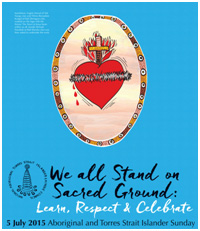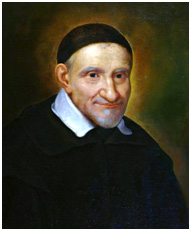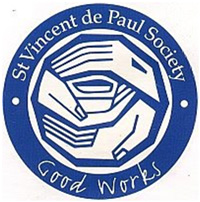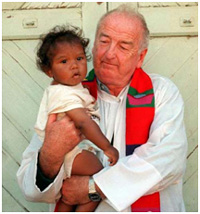Homily for Mass of All Saints Day with Rededication of the Church and Consecration of New Altar, St Vincent de Paul Church, Redfern

Introduction for Mass of All Saints Day with Rededication of the Church and Consecration of New Altar, St Vincent de Paul Church, Redfern, 1 November 2015
Welcome on this All Saints Day to this celebration of the proud history and future promise of St Vincent de Paul Parish in Redfern with the rededication of the restored church building and consecration of a new altar. I acknowledge the Aboriginal and Torres Strait Islander peoples as the traditional custodians of the land we call Australia and the Gadigal people of the Eora Nation as the traditional custodians of the place we call Sydney. As an elder of the Catholic Church I acknowledge the elders of the Aboriginal peoples past and present and recommit my Church to celebrating the Catholic identity of ATSI people, supporting our Indigenous sisters and brothers in their struggle for justice and recognition, and collaborating in various ways for our mutual enrichment.
I am pleased to acknowledge the presence of
- Fr Melvin Llabanes, Parish Priest
- also from the Neocatechumenal communities Toto and Rita Piccolo and other leaders, catechists and itinerants, including Fr Tony Trafford, and from the Redemptoris Mater Seminary Rector Fr Eric Skruzny, Vice-Rector Fr Adrian Gil, and seminarians
- other participating clergy including Mgr Greg Flynn, and Fathers Martin Maunsell, Danai Penollar, Anthony Walsh OP and Fr Fergus Bresnan
- Mr Brunno Fimmano for F.G.A. Granite & Marble and Mrs Mary Roth for Granda liturgical supplies & her Aunt Mary
- Mr Eric Goodwin AM, Chair of the Redfern Jarjum College Council, with Mrs Mary Senj, Chair of its ATSI Advisory Group, who is also State Coordinator for Aboriginal Ed for the CECNSW
- Kim Hill, Auntie Elsie Heiss and Cate Wallace from Aboriginal Catholic Ministry
- Ralph Townsend and Linda Kemp, the two Aboriginal representatives to the Parish Advisory Committee
- members of the local parish, of the local Aboriginal communities, of the Missionaries of Charity and other religious congregations: to everyone present a very warm welcome.
I record our gratitude to
- my predecessor Cardinal Pell for supporting improvements to the lighting, furnishings, sound system, organ, sacristy and loft
- Fr Melvin, the parish community and individual donors for the latest round of improvements including restoring the tabernacle, confessional and disabled ramp, and the provision of the new marble altar, predella and statues, crucifix, stations and sacred vessels
- the NSW Government’s Building Partnerships Program that enabled the provision of the moveable partition doors
- the Daughters of Charity of Sydney who provided a first class relic of St Vincent de Paul to be sealed in the new altar
- all those who gave their labour and advice.
The Rite of Dedication (or in this case Rededication) of a Church and Consecration of an Altar is one of the most ancient and beautiful of our Church. Like the initiation of a new Christian, you will witness the ‘Baptism’ in water, ‘Confirmation’ with sacred chrism, Dressing in White, Giving a Candle, and Celebration of ‘First Holy Communion’ of the new altar. So it is a chance to reflect on our own Christian journey. The Rite also involves the rather dramatic lighting of a fire on the altar and a good deal of smoke, and so echoes the ancient forms of pre-Christian worship of our Jewish forefathers and our Indigenous ancestors.
I have today released a pastoral letter on the Year of Consecrated Life and the role of religious men and women in our Archdiocese. I encourage you to take home a copy and read it or else check out my video message online.
Homily for Mass of All Saints Day with Rededication of the Church and Consecration of New Altar, St Vincent de Paul Church, Redfern, 1 November 2015

His name is most famously associated with the St Vincent de Paul Society. But St Vincent had never heard of the Vinnies – he was long dead when they were invented. Born a French peasant in 1581, our Vincent tried to put his humble origins behind him as he worked his way the ladders of the academy, Church and society, pursuing wealthy patrons and worldly ambitions.
Then something happened that should have radically shocked his system. On the way to prosecuting a debtor, he was captured by pirates and sold into slavery. He eventually escaped, but rather than demonstrating gratitude to God and newfound compassion for the underprivileged such as slaves, he returned to his old ways court. It was only when war came to his land and he saw the devastating impact upon ordinary people that his heart softened.
One thing he now realized was that if society was to improve it needed a better Church; and if the Church was to improve, it needed better clergy. So he founded a congregation of priests devoted to training other clergy known today as “the Vincentians”.

A second thing he now saw was that there were many people in need and people like him had to do something about it. So he rolled up his sleeves and got to work. He built several hospitals for the sick, foundlings, the aged and former slaves, which cared for thousands. He established a Jobstart programme that found work for 40,000 unemployed people. He got projects going to bury the dead poor, distribute seed to struggling farmers, shelter girls from soldiers, and ransom 1200 slaves in North Africa.
A third thing he now realized was that his wealthy friends could and should help. He’d turn up to rich people’s parties wearing nothing but rags and, sure enough, they reached for their cheque-books. (Perhaps Fr Melvin and the other clergy here should try similar fundraising techniques!) Vincent had a particular talent for persuading rich society ladies not only to part with their jewels but also to contribute time and energy to his projects. One of these, St Louise de Marillac, joined him in founding the Daughters of Charity, perhaps better known to us as the flying nuns.
On this All Saints Day these two have much to teach us: that people of all stations and backgrounds can be saints; that they can enrich each other and serve together as saints; that we are, in fact, a communion of saints, mighty and lowly, past, present and future, on earth and in heaven. In 1660 it was Vincent’s turn: after receiving the last sacraments, he died quietly in his chair and joined all saints. By then he’d changed forever what people think of when they hear the word Christian. For many it is coterminous with charitable. No wonder the St Vincent de Paul Society, with their great works of mercy, chose him as patron.

All Saints Day recognises and venerates not only the big name saints like Vincent and Louise, but the unknown ones “from every nation, race, tribe and language” (Rev 7:2-4; 9-14). It says there’s no reason why every member of St Vincent’s Parish should not become a saint on earth – and the sooner the better – so they might be saints in heaven. The Second Vatican Council’s Constitution on the Church (Lumen Gentium) emphasised the universal call to holiness, a call not just to priests, religious, members of SVdP, the Neocatechumenal Way or other movements, but everybody. Indeed the very purpose of priests and religious, apostolic societies and ecclesial movements, parish churches and their interiors, is so everybody might embrace the call to holiness.
As I said, today’s feast underlines not just the diversity but also the communion of saints, including the connection between those already with God and those still on their way. That the Word was made flesh to effect reconciliation and communion on all levels. was another keynote of our golden jubilee Council. Christ’s victory on the Cross was precisely for this: that the disharmonies wrought by sin within people, between people, and between people and God, might be healed as we become a communion of saints. The goal of all reconciliation, including that between Aboriginal Australia and the rest, is not just that we live and let live, but that we eventually walk together as neighbours, friends, siblings: that we experience genuine communion.

But our word ‘communion’ has another and in some ways prior meaning for Catholics: Holy Communion or the Eucharist. And that makes today’s consecration of a new altar and dedication of surrounding fittings a very special event in the life of St Vincent de Paul’s parish and church. This building and its furnishings are here to unite us and raise us up to God, a God who wants not just the Jews, or the French, or the British colonists, but people from every race and class to be His family, as this very parish seeks to demonstrate.
Founded in 1886, this parish has been home to many significant figures in the history of our Church in Sydney, such as Parish Priest Fr Ted Kennedy and his great mate Mum Shirl, whose outreach and ministry to the Indigenous people of this area inspired many. Many other priests, religious and lay people have also laboured in this area: I think for instance of the Pagani family whose missionary work on the streets of this area is so inspiring. At this time of All Saints and All Souls we pay tribute to the great work of all those who have gone before us and as we pray for them we pray also that we might be worthy successors in service to the local community of Redfern and beyond.

Building on that legacy we bless today contributions made by the next generation to the beautification of this place of worship. A fixed, permanent and raised altar as the focal point of the church, is not only required by Church law and practice but goes to the very heart of Catholic faith and worship: it is not only the place for offering the Sacrifice of the Mass, but also anticipates that heavenly future when we hope to join the communion of saints around the altar of God. We pray that that may be so! May God bless this parish! St Vincent de Paul, pray for us!

